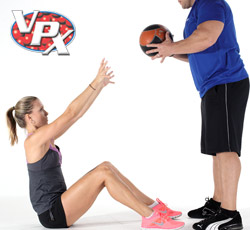These days when I walk around my gym I feel like I always see someone jumping over boxes, throwing medicine balls up to the ceiling, or hopping around like a rabbit. When I go over to these people and ask them why they're doing these specific exercises, their  typical response is either they have a friend that showed this to them or they saw it in on the internet. What they need to understand is that all of the above are variations of plyometric training.
typical response is either they have a friend that showed this to them or they saw it in on the internet. What they need to understand is that all of the above are variations of plyometric training.
In this week’s blog I would like to explain exactly what plyometric training is, what the three phases of plyometrics are, and point to some evidence-based research showing how plyometric training can help you.
Plyometric training is defined as a quick powerful movement involving an eccentric contraction followed immediately by an explosive concentric contraction.
Phase One
In the first phase of plyometrics (the Eccentric Phase, also referred to as the “loading” or “cocking” phase), energy is stored in the muscle in preparation for the following phase.
Phase Two
In the second phase of plyometrics (the Amortization Phase), the muscle with the stored energy is stabilized in preparation for the final phase. For optimal performance, this stage is rapid in order to create a more powerful response.
Phase Three
The third and final phase is the Concentric Phase, also referred to as the unloading phase. This phase occurs immediately after the amortization phase which results in the use of the energy stored in that particular muscle.
"In 2003, Luebbers et al., In a randomized controlled trial with 19 subjects demonstrated that a four week and seven-week plyometric training program enhanced anaerobic power and vertical jump height.
In 2004, Chimera et al., completed a pre-post test control study with 20 healthy Division 1 female athletes, which found that a six week plyometric training program improved hip abductor/abductor coactivation ratios that help control valgus moments at the knee during landing. In addition, the athletes also had significant increase in both sprint speed and vertical jump." 1
As with all training programs, the individual should systematically work themselves up to a level where they can perform plyometric training properly and safely. The individual should have good levels of core strength, flexibility and balance before attempting an extensive plyometric training program.
Once the above level is attained, the individual will need to overload the muscles to avoid plateau. This can be achieved by jumping greater distances, dropping from further heights, or progressing from two legged to one legged jumps.
Happy Hopping :)
References:
1Clark, Micheal, Scott Lucett, and Donald T. Kirkendall. "CHAPTER 8."NASM's Essentials of Sports Performance Training. Philadelphia: Wolters Kluwer/Lippincott Williams & Wilkins, 2010. 208. Print.
Please consult your physician before staring any exercise regimen. The information presented in this article is in no way intended as medical advice or as a substitute for medical treatment.
Clark, Micheal, Scott Lucett, and Donald T. Kirkendall. "CHAPTER 8." NASM's Essentials of Sports Performance Training. Philadelphia: Wolters Kluwer/Lippincott Williams & Wilkins, 2010. 208. Print.







